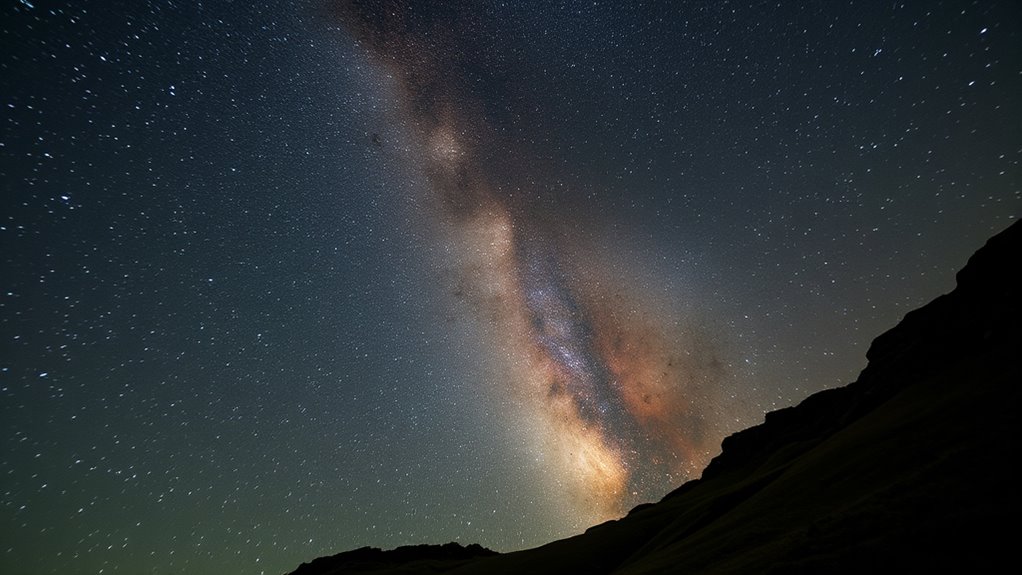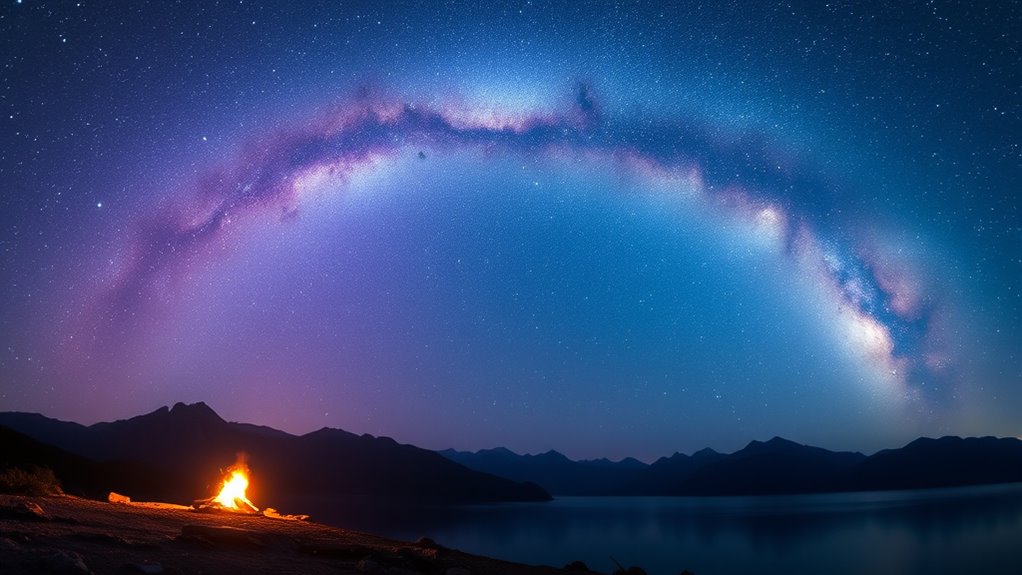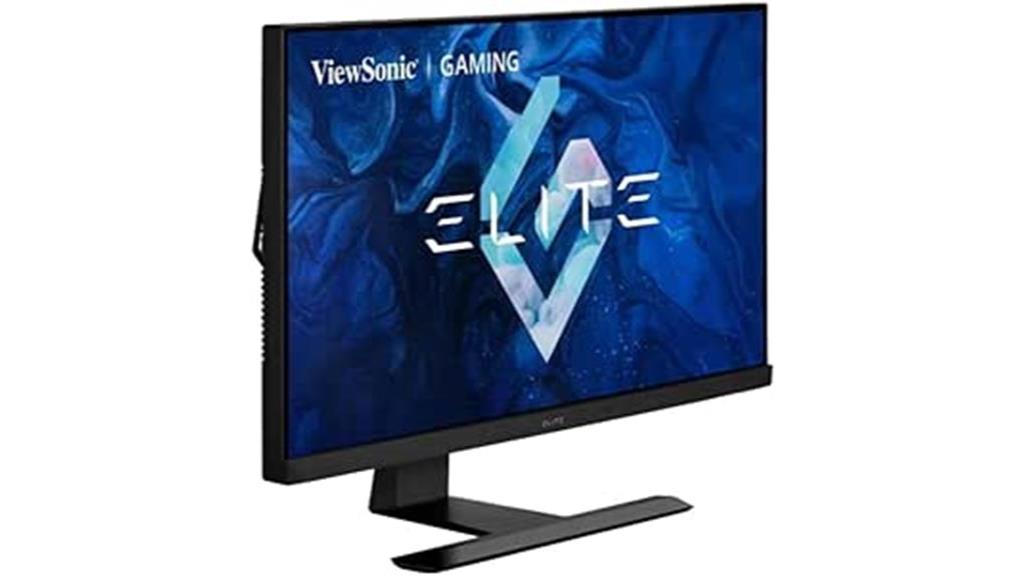If you want to capture the stunning beauty of the Milky Way, I recommend checking out the VILTROX 75mm f/1.2, Sony E 16mm F2.8, VILTROX 75mm f/1.2 PRO E, and AstrHori 6mm F2.8. Each lens excels in low-light performance and offers unique features, like wide apertures and sharp optical quality. These lenses guarantee you get breathtaking shots of the night sky. Stick around, and you’ll uncover more tips and in-depth details!
Key Takeaways
- Opt for lenses with large apertures (f/1.2 to f/2.8) for optimal low-light performance and capturing faint celestial details.
- Choose wide focal lengths (14mm to 24mm) to encompass expansive night sky views and stunning Milky Way shots.
- Look for low-distortion optics and high sharpness to ensure accurate rendering of stars and minimize aberrations.
- Consider lenses with manual focus capabilities, which provide better control for precise star focusing in low-light conditions.
- Ensure compatibility with your camera mount and check for weather sealing for enhanced protection during outdoor astrophotography sessions.
VILTROX 75mm f/1.2 Ultra Wide Angle Auto Focus Lens for Fuji X-Mount Cameras
If you’re a Fuji X-mount camera user looking to capture the stunning beauty of the Milky Way, the VILTROX 75mm f/1.2 Ultra Wide Angle Auto Focus Lens is a fantastic choice. This lens excels in low-light situations, thanks to its large f/1.2 aperture. It makes shooting the night sky a dream, allowing for sharp, detailed images. I love the quick, quiet autofocus, which is perfect for capturing fleeting moments. Plus, it’s built to last, with a design that protects against scratches. Whether you’re shooting photos or videos, this lens gives you the versatility and quality you need for breathtaking night sky photography.
Best For: Photographers and videographers using Fuji X-mount cameras who want to excel in low-light conditions and capture stunning night sky images.
Pros:
- Superior f/1.2 maximum aperture for excellent low-light performance.
- Fast and quiet autofocus thanks to the STM stepper motor.
- Durable design with protective features to prevent lens scratches.
Cons:
- Limited to Fuji X-mount camera compatibility.
- Slightly heavier than other lenses in its class.
- Higher price point compared to standard lenses.
78 D Double Aspheric Lens
The 78 D Double Aspheric Lens is an excellent choice for ophthalmic professionals seeking high-quality imaging during slit lamp examinations. With its 78 diopter power, this lens strikes a perfect balance between field and magnification. I appreciate the extended working distance it offers, enhancing usability considerably. Thanks to the aspheric optics, image quality is superb, with minimal distortion—a must for detailed assessments. Weighing only 5 ounces and compactly sized, it’s easy to handle. Rated 4.4 stars by satisfied customers, this lens proves to be a reliable tool. For quality imaging, I highly recommend the 78 D Double Aspheric Lens.
Best For: Ophthalmic professionals seeking high-quality imaging for slit lamp examinations.
Pros:
- Extended working distance enhances usability and comfort during examinations.
- Aspheric optics improve image quality and reduce distortions for detailed assessments.
- Lightweight and compact design makes it easy to handle during procedures.
Cons:
- Limited availability may affect quick purchasing options for some users.
- Subject to slight variations in specifications due to ongoing research and development.
- Customer feedback indicates a need for competitive pricing to attract more buyers.
Sony E 16mm F2.8 Wide-Angle Prime Lens (SEL16F28)
Looking for a lightweight and compact lens that’s perfect for capturing stunning Milky Way images? The Sony E 16mm F2.8 Wide-Angle Prime Lens (SEL16F28) might just be your ideal companion. Weighing in at just 67g and measuring 22.5mm in length, it’s ultra-portable for travel. With a bright F2.8 aperture, it performs well in low light, producing sharp, vibrant images. Plus, its minimum focus distance of 0.24 meters lets you get creative with close-ups. While it may not meet the demands of professional settings, it’s fantastic for casual photography, making those starry nights truly unforgettable.
Best For: Travelers and casual photographers seeking a lightweight and compact lens for stunning landscapes and Milky Way photography.
Pros:
- Ultra-compact and lightweight design makes it easy to carry on trips.
- Bright F2.8 aperture provides excellent low-light performance for night photography.
- Minimum focus distance of 0.24 meters allows for creative close-up shots.
Cons:
- May not meet the demands of professional photography settings.
- Limited versatility compared to zoom lenses for varied compositions.
- Customer reviews indicate mixed satisfaction, averaging 3.0 out of 5 stars.
VILTROX 75mm f/1.2 PRO E Lens for Sony E-Mount Cameras
For those passionate about capturing the Milky Way’s stunning beauty, the VILTROX 75mm f/1.2 PRO E Lens stands out with its exceptional f/1.2 maximum aperture. This lens is perfect for low-light conditions, making it ideal for astrophotography. With 16 elements in 11 groups, it delivers sharp images and impressive resolution. I love the fast autofocus, which supports eye and face detection, ensuring I never miss a moment. Weighing about 2.79 pounds, it feels solid yet manageable in the field. If you’re looking for a budget-friendly lens that excels in various shooting scenarios, this one’s definitely worth considering.
Best For: Enthusiasts and professionals seeking a high-performance, budget-friendly lens for astrophotography and versatile shooting scenarios.
Pros:
- Excellent f/1.2 maximum aperture for low-light performance and beautiful depth of field.
- Fast and accurate autofocus with eye and face detection for capturing sharp images.
- Solid build quality and lightweight design, making it easy to handle in the field.
Cons:
- Some users report minor vignetting and slower focus in low-light conditions.
- Lacks image stabilization, which may affect handheld shooting in certain situations.
- Compatibility issues with some older Sony cameras may limit usability.
AstrHori 6mm F2.8 Circular Fisheye Lens for Nikon Z Mount
AstrHori’s 6mm F2.8 Circular Fisheye Lens is perfect for photographers who crave a unique perspective, especially when capturing the expansive beauty of the Milky Way. With a 220° ultra-wide field of view, this lens creates immersive circular images that truly stand out. The large F2.8 aperture ensures sharp, vibrant shots in low light, making it ideal for astrophotography. Plus, its all-metal, compact design makes it travel-ready. I love the manual focus ring for precise adjustments, which allows me to release my creativity in various settings. Whether it’s landscapes or architecture, this lens elevates my night photography game.
Best For: Photographers seeking a unique, ultra-wide perspective for astrophotography and creative landscapes.
Pros:
- 220° ultra-wide field of view creates immersive circular images for stunning visual effects.
- Large F2.8 aperture ensures sharp images even in low-light conditions, ideal for night sky photography.
- All-metal, compact design makes it durable and travel-friendly for outdoor shoots.
Cons:
- Manual focus only may require additional practice for precise adjustments, especially for beginners.
- Limited compatibility as it’s specifically designed for Nikon Z full-frame mirrorless cameras.
- Bold edge distortion may not be suitable for traditional photography styles, limiting versatility.
Factors to Consider When Choosing Wide-Field Lenses for Milky Way Photography

When I choose a wide-field lens for capturing the Milky Way, I focus on several key factors. Aperture size is essential for low-light performance, while focal length impacts how much of the sky I can include in my shots. I also consider distortion and sharpness, along with the lens’s build quality and whether I want to use autofocus or manual focus.
Aperture Size Importance
While choosing a wide-field lens for Milky Way photography, understanding the importance of aperture size is essential. A larger aperture, with a smaller f-number, lets in more light, which is vital for capturing the faint details of the Milky Way in low-light conditions. I typically recommend lenses with an aperture of f/1.2 to f/2.8 to maximize light intake and minimize exposure times. These wide apertures not only yield brighter star images but also enhance the visibility of celestial features in dark environments. Additionally, a lens with a large aperture creates better background separation, adding depth to your astrophotography compositions. Ultimately, the aperture size directly affects your camera’s performance in night photography, balancing exposure, noise, and image clarity.
Focal Length Considerations
After considering aperture size, the next key factor in selecting a wide-field lens for Milky Way photography is focal length. Typically, I find that a focal length between 14mm and 24mm works best for capturing those expansive night sky views. If I opt for shorter focal lengths like 14mm or 16mm, I get a broader field of view, which allows me to include more of the sky and landscape in my frame. On the other hand, longer focal lengths like 20mm or 24mm give me a narrower perspective, helping to focus on specific celestial details. Ultimately, my choice of focal length hinges on whether I want to capture the vastness of the Milky Way or zero in on particular sections of the sky.
Distortion and Sharpness
Choosing the right wide-field lens for Milky Way photography means paying close attention to distortion and sharpness. I’ve learned that lenses with lower distortion levels provide more accurate rendering of stars and the Milky Way, which is essential for capturing the night sky. Sharpness across the entire frame is equally important; it lets me capture fine details of celestial objects and landscape features. I always look for lenses with high-quality optical elements, like aspherical or high-refractive index glass, to minimize aberrations that can blur my images. Distortion can stretch or warp stars, especially at the edges, so I prioritize lenses with minimal distortion. This balance of sharpness and distortion ensures my photos truly reflect the beauty of the night sky.
Build Quality and Durability
When I head out for Milky Way photography, I know that build quality and durability are just as essential as optical performance. A sturdy, weather-sealed construction protects my lens from dust and moisture, which is crucial for outdoor night shoots. I prefer lenses with an all-metal or high-quality plastic body, as they enhance durability during frequent transport and setup. Reinforced lens mounts ensure a secure attachment to my camera, minimizing the risk of damage from accidental impacts. Additionally, I look for lens coatings that resist scratches and dust buildup, maintaining optical clarity over time. Finally, robust focusing mechanisms, like precision manual focus rings, give me reliable control for achieving sharp focus in low-light conditions.
Autofocus vs. Manual Focus
While I appreciate the convenience of autofocus systems in wide-field lenses, they often struggle in the dim conditions of Milky Way photography. I’ve noticed that these systems can hunt for focus or miss entirely in dark, featureless night skies, which can be frustrating. That’s why I often turn to manual focus for precision. It allows me to control the focus distance, ensuring sharp stars and celestial details. Using live view magnification, I can fine-tune the focus right on distant stars or the core of the Milky Way. Ultimately, the choice between autofocus and manual focus depends on my experience, the lens’s performance in low light, and my specific shooting needs. For me, manual focus has proven to be more reliable.
Lens Compatibility Factors
Selecting the right wide-field lens for Milky Way photography is vital, as various compatibility factors can greatly impact your results. First, confirm the lens matches your camera’s mount type, like Sony E-mount or Nikon Z-mount, for proper attachment. If you prefer autofocus for capturing stars, check if the lens supports it; otherwise, manual focus may be necessary for accuracy. Make sure the lens’s sensor coverage aligns with your camera’s sensor size—APS-C or full-frame—to avoid vignetting. Additionally, verify compatibility with your camera’s firmware to utilize features like electronic aperture control. Finally, consider the lens’s build quality and weather sealing; these are essential for outdoor astrophotography in low-light and challenging conditions.
Low-Light Performance
Low-light performance is essential for capturing the stunning details of the Milky Way, and choosing the right wide-field lens can make all the difference. I always look for lenses with large maximum apertures, like f/1.2 or f/2.8, as they let in more light, considerably improving my nighttime shots. Fast lenses enable longer exposure times without introducing excessive noise, allowing faint celestial details to shine through. I appreciate having the ability to manually control aperture settings, giving me flexibility in adjusting light intake for ideal visibility. Lenses tailored for low-light conditions also minimize aberrations and enhance contrast, ensuring clarity. Plus, high-quality glass elements and coatings reduce flare and ghosting, making those dark sky images truly pop.
Weight and Portability
When I’m out capturing the Milky Way, I quickly realize that the weight and portability of my lens can make or break the experience. Lighter lenses, typically under 1 pound, are a game changer for long outdoor night shoots. They reduce fatigue, allowing me to focus on the beauty of the stars. Compact lenses fit easily into my camera bag, making travel more convenient. This portability lets me set up quickly in remote locations, minimizing the risk of missing those perfect shooting moments. While I might sacrifice some advanced features for a lighter setup, finding a balance between weight and optical performance is vital for my astrophotography success. Ultimately, the right lens enhances both my comfort and creativity under the night sky.
Frequently Asked Questions
What Is the Best Aperture for Milky Way Photography?
I’ve found that an aperture of f/2.8 or wider works best for Milky Way photography. This setting allows more light to hit the sensor, helping to capture those stunning details in the night sky. I usually aim for f/2.8, but if I have a lens that opens wider, I’ll take advantage of it. Remember to balance it with shutter speed to avoid star trails, and you’ll be amazed at the results!
Can Wide-Field Lenses Be Used for Daytime Landscapes?
Absolutely, I’ve used wide-field lenses for daytime landscapes, and they work beautifully! Their ability to capture expansive scenes makes them perfect for sweeping vistas. I love how they bring out details in the foreground while keeping distant elements sharp. Just remember to take into account the lighting and composition; a good lens can make all the difference in achieving that stunning shot. So, don’t hesitate to take them out during the day!
How Do I Prevent Star Trails in My Photos?
Did you know that even a 30-second exposure can create noticeable star trails? To prevent them, I always use a tripod and keep my shutter speed under 20 seconds, depending on my lens. I also set my camera to a higher ISO to compensate for the shorter exposure. If I’m still worried, I shoot in continuous mode and stack the images later for a cleaner result. Happy shooting!
What Camera Settings Are Ideal for Milky Way Shots?
For stunning Milky Way shots, I typically set my camera to manual mode with an aperture of f/2.8 or wider. I adjust the ISO between 1600 and 3200 to capture more light, and I use a shutter speed of 15-30 seconds to avoid star trails. It’s essential to focus on the stars, not the foreground. I also recommend shooting in RAW for better post-processing flexibility. Happy shooting!
Do I Need a Tripod for Milky Way Photography?
Imagine trying to balance a delicate glass sculpture on a wobbly table—that’s what shooting the Milky Way without a tripod feels like! Yes, you absolutely need a tripod for Milky Way photography. It keeps your camera steady during long exposures, allowing you to capture those stunning stars without blur. I’ve learned that a sturdy tripod is essential for achieving sharp, breathtaking shots of the night sky. Trust me, it’s a game-changer!
Conclusion
In conclusion, discovering the perfect wide-field lens for Milky Way photography can feel like stumbling upon a hidden gem in the night sky. With options like the VILTROX 75mm and AstrHori 6mm, you’re bound to find the right fit for your camera and style. Imagine standing under a blanket of stars, capturing their brilliance with ease. So grab your gear, step outside, and let these lenses elevate your night sky adventures to new heights!















